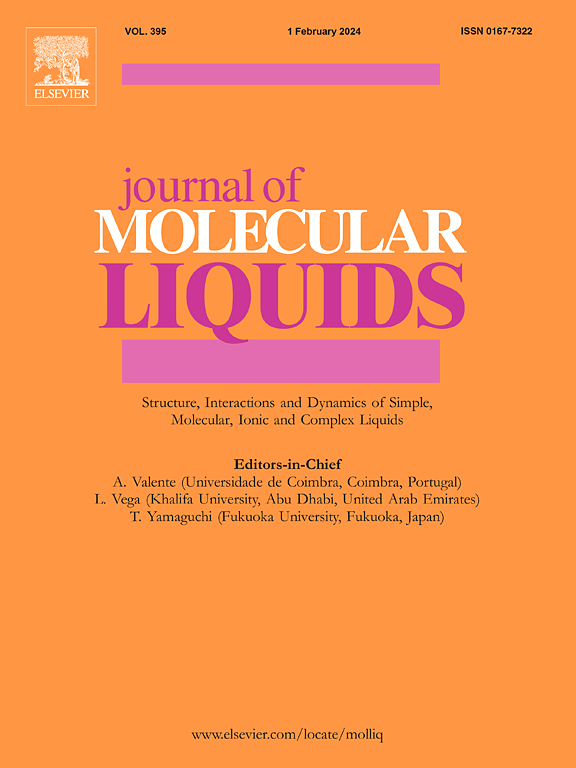N-油酰基肌氨酸(N-OSS)和十二胺(DDA)对从白云石中选择性浮选黝帘石的协同收集效应
IF 5.3
2区 化学
Q2 CHEMISTRY, PHYSICAL
引用次数: 0
摘要
本研究将 N-OSS 与 DDA 结合作为一种新型收集器进行了研究。研究全面考察了它们的收集性能及其协同作用机制。微浮选结果表明,N-OSS/DDA 无需预活化即可表现出优异的分离选择性。接触角测试表明,N-OSS/DDA 可选择性地增强黝帘石的疏水性,而对白云石的疏水性几乎没有影响。傅立叶变换红外光谱(FTIR)、扫描电子显微镜(SEM-EDS)和 Zeta 电位显示,N-OSS/DDA 可能会共同吸附在刚玉表面,而不是白云石表面。XPS 分析和 DFT 计算推断,N-OSS 中 -COO- 的 O1 2p 轨道可与 Al 3s 轨道结合,DDA 的 -NH3+ 基团通过氢键和静电吸引吸附在白云石表面。同时,N-OSS 和 DDA 之间的氢键作用促进了它们在刚玉表面的共吸附。而 N-OSS/DDA 则通过物理吸附作用弱地吸附在白云石表面。N-OSS/DDA 具有出色的可浮性,也许是未来传统收集器的良好替代品。本文章由计算机程序翻译,如有差异,请以英文原文为准。
The synergetic collecting effect of N-oleoyl sarcosine (N-OSS) and dodecylamine (DDA) on the selective flotation of spodumene from albite
In this study, N-OSS combined with DDA was examined as an novel collector. The collecting performances and their synergetic interaction mechanisms were investigated comprehensively. The micro-flotation results illustrated N-OSS/DDA exhibited excellent selectivity on separation without pre-activation. Contact angle tests revealed N-OSS/DDA could selectively enhance the hydrophobicity of spodumene, whereas, they barely affected that of albite. FTIR, SEM-EDS and Zeta potential revealed N-OSS/DDA might co-adsorb on spodumene surface rather than that of albite. XPS analysis and DFT calculations inferred the O1 2p orbitals of -COO- within N-OSS could bond with Al 3s orbitals and the -NH3+ groups of DDA adsorbed onto spodumene surface via hydrogen bonding and electrostatic attraction. Meanwhile, the hydrogen bonding between N-OSS and DDA promoted the co-adsorption on spodumene surface. While N-OSS/DDA weakly adsorbed on albite surface through physical adsorption. N-OSS/DDA exhibited outstanding floatability, which maybe a good substitute for conventional collectors in future.
求助全文
通过发布文献求助,成功后即可免费获取论文全文。
去求助
来源期刊

Journal of Molecular Liquids
化学-物理:原子、分子和化学物理
CiteScore
10.30
自引率
16.70%
发文量
2597
审稿时长
78 days
期刊介绍:
The journal includes papers in the following areas:
– Simple organic liquids and mixtures
– Ionic liquids
– Surfactant solutions (including micelles and vesicles) and liquid interfaces
– Colloidal solutions and nanoparticles
– Thermotropic and lyotropic liquid crystals
– Ferrofluids
– Water, aqueous solutions and other hydrogen-bonded liquids
– Lubricants, polymer solutions and melts
– Molten metals and salts
– Phase transitions and critical phenomena in liquids and confined fluids
– Self assembly in complex liquids.– Biomolecules in solution
The emphasis is on the molecular (or microscopic) understanding of particular liquids or liquid systems, especially concerning structure, dynamics and intermolecular forces. The experimental techniques used may include:
– Conventional spectroscopy (mid-IR and far-IR, Raman, NMR, etc.)
– Non-linear optics and time resolved spectroscopy (psec, fsec, asec, ISRS, etc.)
– Light scattering (Rayleigh, Brillouin, PCS, etc.)
– Dielectric relaxation
– X-ray and neutron scattering and diffraction.
Experimental studies, computer simulations (MD or MC) and analytical theory will be considered for publication; papers just reporting experimental results that do not contribute to the understanding of the fundamentals of molecular and ionic liquids will not be accepted. Only papers of a non-routine nature and advancing the field will be considered for publication.
 求助内容:
求助内容: 应助结果提醒方式:
应助结果提醒方式:


